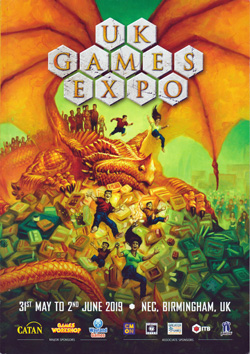 Three halls of games
Three halls of games
Pevans reports from the 2019 UK Games Expo
My report is written as a narrative to be read through and focuses on the new (to me) games I played. You can start with my introduction or use the indexes below to find something specific.
It is also available as a PDF document: UK Games Expo 2019 report (5 Mb). (You will need Adobe Reader to view this document – use the link to download it if necessary.)
- Specific Exhibitor or game
- The Retailer Summit – Asmodee's Thursday showcase
- Press Preview – an early look at some of the new games
- And... it's open (or, what I did on Friday)
- One Hall to go – all the rest
Exhibitor index
Game index
| Game | Rating |
|---|---|
| Attention All Shipping (prototype) | 8* |
| Brexit: the Real Deal (prototype) | 8** |
| Britannia + Duel Britannia | 10 |
| Car Wars 6th ed (prototype) | - |
| Catan Compact edition | - |
| Deadly Doodles | - |
| Dual Clash Poker | - |
| Foothills | - |
| Galactic Era (prototype) | - |
| Gladiatores: Blood for Roses | 6* |
| The Great Alcatraz Escape (prototype) | - |
| High Rise (prototype) | 7* |
| Home on Lagrange | 8* |
| Jonathan Strange & Mr Norrell | 8** |
| Judge Dredd: Helter Skelter | - |
| La Stanza | 8* |
| Lonely Bears | - |
| Megacity: Oceania (prototype) | 10** |
| Memoir '44: New Flight Plan intro and demo game | 10* |
| Milito | - |
| Mob Sitters (prototype) | 7** |
| Mr Face | - |
| Museum | 9* |
| Ratings are out of 10, on my highly subjective scale * Provisional rating (after playing once) ** enthusiasm rating (after an introduction to the game) |
|
| Game | Rating |
|---|---|
| Nine Tiles Panic | - |
| NObjects | - |
| On the Underground 2nd ed (prototype) | 9 |
| Party Politics | - |
| Periodic: A Game of the Elements | - |
| Pocket Landship (prototype) | - |
| Rolling Bears (prototype) | 6* |
| Rome & Roll (prototype) | - |
| Runestones (prototype) | 9** |
| Smash City | - |
| Smile | 8* |
| Snitch | - |
| Solar Storm (prototype) | 7** |
| Tal der Wikinger | - |
| Terror Below | 6** |
| Ticket to Ride: London | 5* |
| Titan (prototype) | 9** |
| Trial of the Temples (prototype) | - |
| Undaunted: Normandy | - |
| Undo | 8 |
| Villagers | - |
| Wing It | - |
| X-Arrr! | - |
| Zoom in Barcelona (prototype) | 7** |
| Ratings are out of 10, on my highly subjective scale * Provisional rating (after playing once) ** enthusiasm rating (after an introduction to the game) |
|
At the Retailer Summit
The Expo officially opened on Friday (31st May) morning, but I put on my Games from Pevans hat for the Retailer Summit run by Asmodee UK (formerly Esdevium Games) on Thursday. This is an opportunity for publishers to show their new games to retailers, many of whom will be busy for the rest of the event.
My notes are in no logical sequence, just the order I saw them in. Starting with the games from Pegasus, designed by Michael Palm and Lucas Zach. This is a series of co-operative card games with the same theme: players visit specific points in a timeline to try to prevent the event initially presented. Thanks to Pegasus’s gift of Undo: Blood in the Gutter, I have played this one subsequently.
Opening the box, you are confronted with a deck of large cards warning you not to shuffle them. The first few cards introduce you to the story and tell you how to set up the game. You then have a line of the cards, each dated and timed, in the order in which they take place. The players have a limited number of opportunities to select an event, turn over the card and read what happened at that time. And can look at an even more limited number of the additional clue cards, one per time slot.

The special demo version of Undo at UK Games Expo
At the bottom of each card are three options of what to do (in best roll-your-own-adventure style), which is when the debate really kicks in. Eventually, the players will decide which one to choose and then look up the appropriate answer (a separate deck of cards, making it unlikely you’ll accidentally see other answers). This will give you a number: positive, negative or zero.
Once you’ve finished, the aggregate of these numbers gives your result. Depending on what range your result falls into, there’s a little conclusion to the story, which wraps up the game nicely. Six of us played this at the June G3 Day and everybody was immediately involved in the story. We quickly developed a hypothesis as to what was going on and made decisions on this basis. Luckily, we were right and reached a highly satisfactory conclusion.
And there’s the rub. Having played this once and succeeded, am I going to play it again? Well, possibly, once enough time has lapsed. And I’d be more likely to do so if we hadn’t made such a good job of it. Even if it’s a play-once game, Undo: Blood in the Gutter was great fun and makes the rest of the series attractive. If they’re priced right, I can see these little games doing well. I’ll give the series (rather than individual games) 8/10 on my highly subjective scale.
Other games on the Pegasus stand included NObjects, designed by Ludovic Gimet. This is a party game where players have to guess what one of them is drawing. Except that they’re drawing with a finger on the table, so the others have to follow the movements and imagine the drawing. Pegasus rep Christian Stenner demonstrated this and I completely failed to work out what he was attempting to tell me. (No wisecracks, please.) Definitely not my kind of thing.
Who would publish a 15-minute game of drawing paths through dungeons? Billed as a “Draw ’n’ draw” game, Deadly Doodles is published by Steve Jackson Games and was designed by Samuel Mitschke and Randy Scheunemann. It’s a quick-playing dungeon bash: one player draws a card and everybody extends a passageway on their dungeon map. Connecting to things scores you points. And at least it doesn’t have “Munchkin” on the cover.
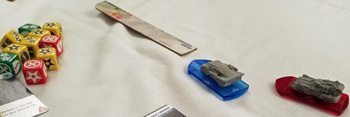
Prototype models and components for Car Wars 6th edition
Gamers who go back as far as I do will remember Car Wars and SJG has a sixth edition of this Mad Max-style combat game for later in the year.
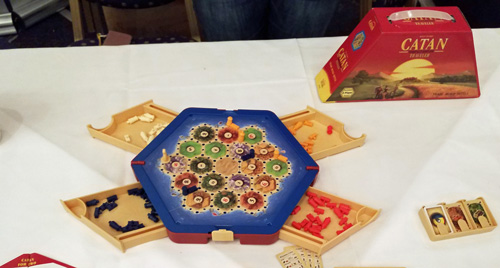
The cleverly-designed travel edition of Catan (Catan: Compact edition)
Strolling past Catan Studio’s table, I was rather taken with the neat travel edition of Catan (Settlers of Catan as far as I’m concerned), which I hadn’t seen before. It’s a modular peg board, with the pegs in trays underneath, which is also where the mini cards are stored. The whole thing then folds up to fit into the neat half-hex box.
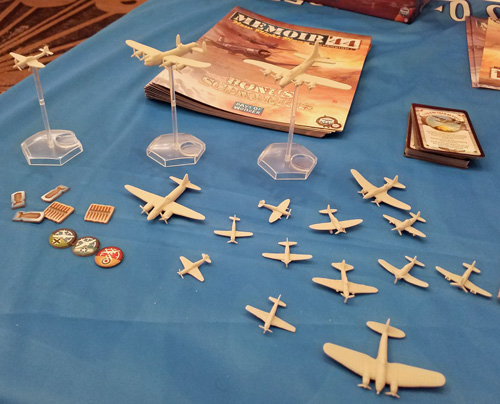
Display of Memoir '44: New Flight Plan at UKGE 2019 with all the models on show
There was lots of good stuff from Days of Wonder, but two things stood out for me. The first was the new expansion for Memoir ’44, which is called New Flight Plan (Richard Borg being the designer). It adds aircraft to the WW2 battlefields of the game, replacing the long out-of-print Air Pack. I tried it out at the Expo proper, so I’ll have more on this later.
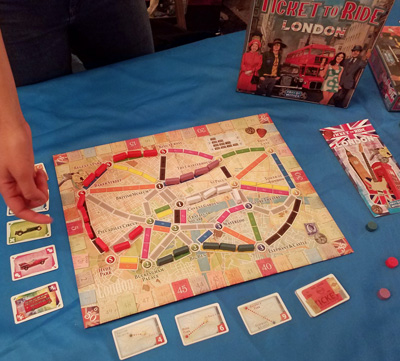
Ticket to Ride: London on display
The other thing was Ticket to Ride: London, Alan Moon’s latest addition to the range. This follows in the mould of last year’s Ticket to Ride: New York, being a small, 15-minute game. DoW let me have a copy (thanks, guys) so this is another one I’ve had the chance to play since the Expo.
And it is Ticket to Ride. Just with fewer pieces (double-decker buses in this case). Game play is what you’d expect: draw cards or play cards to complete a connection between stops. Connections score points with end-game bonuses for completed tickets (a particular route) and if you’ve connected all the stops in a ‘region’ (same colour).
The issue with this, for anyone who enjoys Ticket to Ride, is that it’s all over too quickly. You feel like you’re just getting started when the game finishes. It’s certainly a neat introduction to the game’s mechanics, but I suspect it’s aimed more at the tourist market than gamers. It gets a provisional 5/10 on my highly subjective scale.
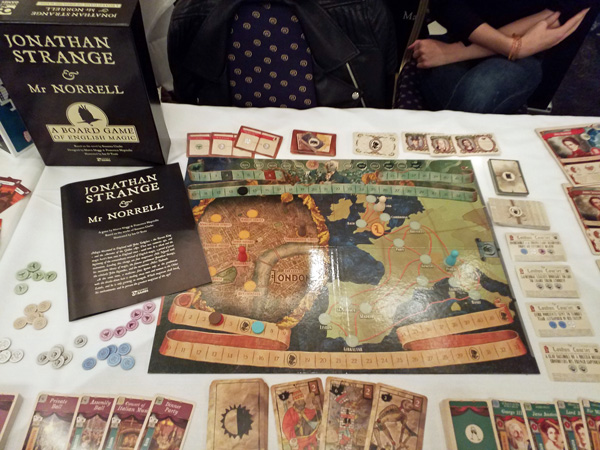
Jonathan Strange & Mr Norrell looks the business
Jonathan Strange & Mr Norrell looked good on the Osprey table. It is, of course, based on Susanna Clarke’s terrific novel of the same name (see TWJO 165 for my thoughts on this). Players mooch around London, England and Europe, collecting the ingredients they need to perform feats of magic. The aim is to become the foremost practitioner of English magic. However, you must also accumulate more points than ‘the gentleman with the thistledown hair’. I look forward to trying this one and seeing how well it re-creates the atmosphere of the book.
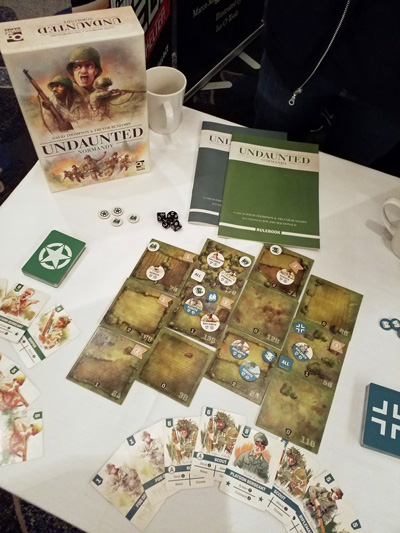
Undaunted: Normandy on display
Judge Dredd: Helter Skelter and Undaunted: Normandy, were also on Osprey’s table. The former is a skirmish game set in the world of the eponymous anti-hero that Martin Wallace has developed from his Wildlands game. The latter is a two-player card game of the Normandy battles post-D-Day. Players win by achieving their scenario objectives, while destroying enemy units reduces their opponents’ hand size.
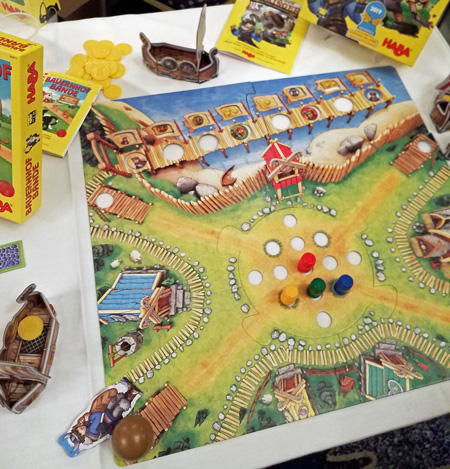
The delightful Tal der Wikinger
I took a quick look at Haba’s Tal der Wikinger (Viking Valley, designed by Marie and Wilfried Fort) as it’s nominated for this year’s children’s Spiel des Jahres. You roll a ball at the skittles in the middle, allowing you to move tokens for the Vikings whose skittles you knocked over, aiming to leave yours in a scoring position to take some gold. Most gold in your boat wins after several rounds. It looks great and has some tactical opportunities.

There's antimony, arsenic, aluminum, selenium,
And hydrogen and oxygen and nitrogen and rhenium…
A game about the periodic table? Yes, that’s Periodic: A Game of The Elements, published by Genius Games and designed by John Coveyou and Paul Salomon. Players expend energy to move around the table or to pick up chips. They can collect sets of elements to match a current goal and move round groups of elements to advance around the Academic Achievements. Both of these score points, so players certainly have options of what to do. There’s definitely a strong educational element to this, I just don’t know how much of a game it is.
Stopping at Renegade Game Studios, I spotted Terror Below, designed by Mike Elliott. It’s a pick-up-and-deliver game in a desert setting. It’s possible giant worms will burst out of the ground and squash your vehicle. But, really, how likely is that?
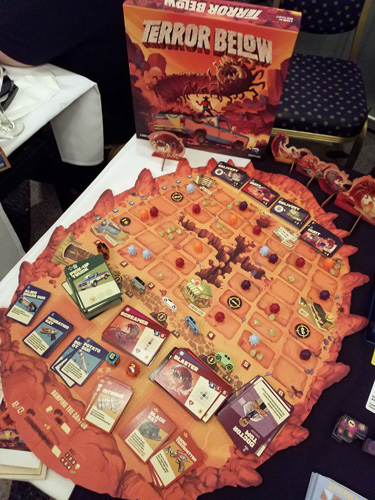
Bad vibrations: Terror Below
The issue for players is that travelling around causes vibrations that attract the worms. Ideally, you want to create just enough noise that the next player triggers an attack. But that can go wrong in so many ways… This looks good fun and I’d definitely give it a go. Renegade’s representative was keen to make it clear that the game has nothing to do with a certain film (of which I have fond memories, having watched it late at night with several bottles of spirits and good company in a very cold chalet when attending the first UK Gen Con).
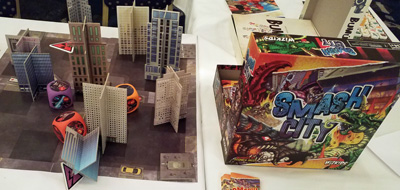
Bye bye, skyscrapers! And that’s just collateral damage in Smash City
When I saw Wizkids’ Smash City, designed by Stephen Avery, on the table, I hoped it involved chucking giant dice at cardboard skyscrapers. However, Wizkids’ Zev Shlasinger enlightened me: the dice are players’ monsters fighting each other through the city. Any buildings toppled are purely collateral damage. There’s clearly a dexterity aspect to the game, I don’t know about tactical elements. Still, it would be fun finding out.
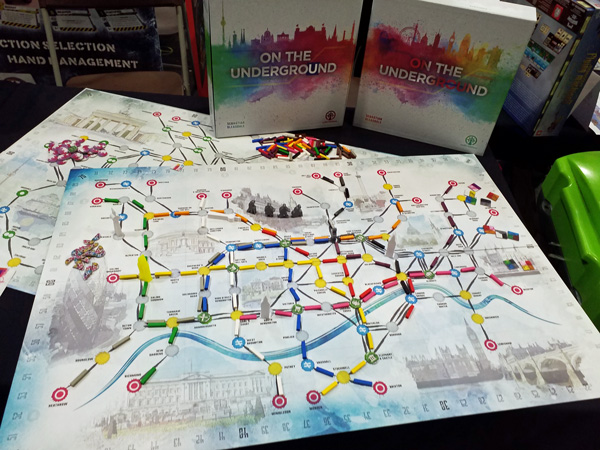
Nice new edition of On the Underground, London map on top
In recent months I’ve had the pleasure of trying Sebastian Bleasdale’s Berlin map for his On the Underground at Swiggers games club. LudiCreations unveiled the new edition of the game at the Expo: original London map on one side of the board, Berlin on the other. The first edition dates back to 2006 and is long out of print, so it’s great to see it back again – especially when LudiCreations have done a great job on the production.
If you haven’t played the original, the game is about building underground railways. Each turn, players place wooden sticks to extend their lines, linking up stations as they go. Then the ‘passenger’ moves to a couple of stations, scoring points for the players whose lines it uses. This makes for a big tactical element as each turn players are trying to attract the passenger.
However, there are other ways of scoring points – with some different goals according to the board being used – and the strategic planning of building for future passenger movements. I reviewed the original game in TWJO 73, giving it 9/10 on my highly subjective scale, and see no reason to change that rating.
Time for the Press
After checking in at my hotel and meeting up with my roommate, Peter Card, I switched to my To Win Just Once hat to attend the Expo’s press preview on Thursday evening. Had all the tables been occupied, I reckon there would have been 150-odd games publishers represented. I skipped through, stopping to look at the occasional item.
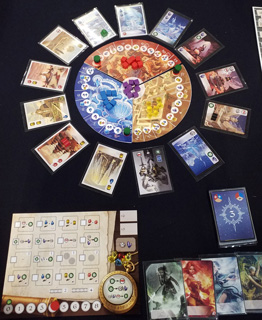
Trial of the Temples on display
EmperorS4 had several games on display, including Trial of the Temples (designed by Wei-Min Ling and Michael Mihealsick). The idea of this one is a contest between wizards who have to collect the correct ingredients for their own spells while blocking their opponents. I didn’t follow all the explanation, but players need to advance on all three central tracks while picking up resources to power their particular abilities.
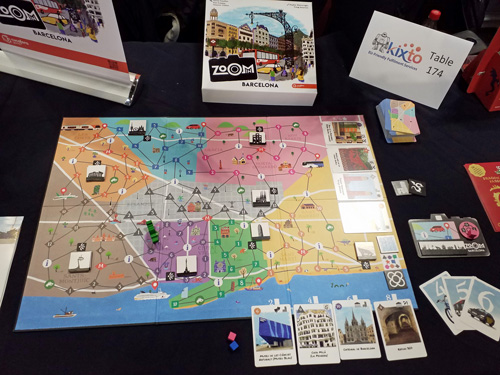
It took me a while to find Las Ramblas on the board
Having visited the city several times, Zoom in Barcelona caught my attention. Designed by Núria Casellas, Eloi Pujadas, Joaquim Vilalta and published by Cucafera Games, it’s a family game of capturing the sights and landmarks. Players travel around the map of the city on the board, taking ‘photos’ as they go: best collection wins. The advanced game adds more strategy as players are trying to re-create the skyline goal they start with. It looks good fun and the finished game is expected at Spiel this year.
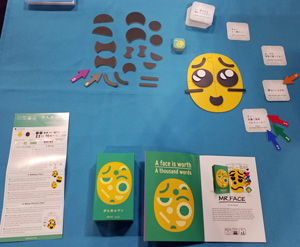
Here’s Mr Face!
Oink had three new games at the press preview with at least one more due to arrive. Mr. Face, designed by Jun Sasaki, has players trying to work out what one player’s caricature of a face represents. Nine Tiles Panic is designed by Jens Merkl and Jean-Claude Pellin and gives each player nine tiles depicting parts of a city. Each round, players scramble to get their tiles into what they hope will be the top-scoring combination according the goal revealed. Takeshi Matsushita and Tatsuya Iwakura designed Dual Clash Poker, which uses a well-tried mechanism. Each player has the same set of cards and plays one. High card wins. Unless there’s a tie, when next highest wins… It’s an oldie but goodie and the twist here is that players are in pairs, so there’s every opportunity to mess up your partner’s play.
Wotan Games are working on a timely satirical game, Brexit: the Real Deal. Designed by Russell Neal, this card game is set after Britain’s departure from the EU has splintered the United Kingdom into its constituent nations. Players represent different factions, competing to negotiate trade deals with other countries. However, each has their own hidden agenda (one of which may be just dragging the game out without a conclusion…). Expect this on Kickstarter in due course. Wotan also had Party Politics, an entertaining little Werewolf/Mafia variant where the players are politicians and civil servants trying to identify – and fire – whoever leaked an important document. Each character has their own restrictions and goal (the Prime Minister wins if anyone is sacked!).
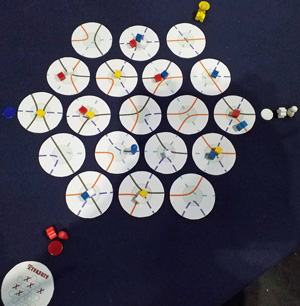
X Arrr, me hearties!
Designed by Keith McLeman, X Arrr! will come from his imprint, Cardboard and Coffee Games. There’s no artwork yet, so it looks very abstract at the moment, but will have a piratical theme. The aim is to collect your treasure from several islands by moving your pirate along its current track. But first you can rotate an island or switch to a different track. You can immediately see the challenge of the game, the right artwork will make it even tougher.

The engines canna take a Solar Storm, Captain
Solar Storm is a co-operative game of repairing the player’s spaceship before it falls into the sun. Where’s International Rescue when you need them? Designed by Ayden Lowther and published by Dranda Games (I’m guessing one of the team has a doctorate and the other’s name starts with an ‘A’), it looks fun and should be on Kickstarter in September.
And… it’s open
Moving on to Friday, the Expo officially opens. Yay! Cue hordes of gamers keen to purchase the very latest game/expansion. And I can settle down to playing some of them. Peter Card, my usual wingman, was with me on Friday – he had a date with a wargaming tournament for Saturday and Sunday. As last year, the trade hall took up Hall 1 and a good half of Hall 2 with tournaments taking place in the rest of Hall 2 (along with the open gaming area fuelled by Thirsty Meeples’ games library) and Hall 3 – and some events at the Hilton Metropole.
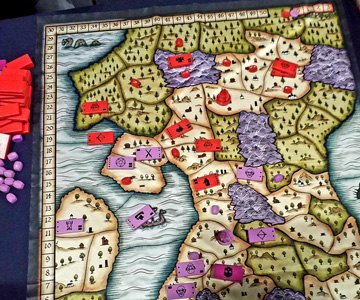
The Runestones prototype showing the Mah Jongg-style chunky tiles
Starting at the main entrance to Hall 1, our first stop was PSC Games. Here we found designer Martin Wallace promoting his latest, Milito. This is a development of his 2013 card wargame, Fields of Glory: the card game. Players are trying to win in three sections of the battlefield. They deploy military units (cards) into each section and then fight against their opponent’s forces. Having played the original game (see my Spiel '13 report), I passed on this one.
However, Martin also had a prototype with the working title of Runestones. This is a multi-player wargame in a fantasy setting using the mechanisms from his clever American Civil War game, Lincoln. However, this game has domino-style tiles rather than cards, with each faction having its own advantages and disadvantages. It’s difficult to get a multi-player wargame to work, but the clever disparities between the nations should make for some very different strategies.

The Rome & Roll prototype – plus David's right forearm
Another designer on the PSC stand was David Turczi, demonstrating the prototype of Rome & Roll. This applies the roll-and-write mechanism to the rebuilding of ancient Rome under Nero following the great fire. Players use the dice rolls to add buildings (polyomino shapes) to their layout of Rome, conquer new provinces and expand the network of roads. Each player also has their own special ability. I think I may be suffering from over-exposure to roll-and-write games as I couldn’t summon up the enthusiasm to look more closely at this.

Meet Classic Britannia – same as the old Britannia, only with plastic soldiers
On the other hand, I was fired up by the news that PSC is planning a new edition of Lew Pulsipher’s Britannia. It’s a classic that I thoroughly enjoy – though it generally only gets played at conventions when there’s enough time to do it justice. This version will have minimal changes from the second edition (published by Fantasy Flight in 2008), but will use models rather than cardboard tokens – well, PSC does stand for Plastic Soldier Company.
The box will also contain a quick-playing two-player version: Duel Britannia. This uses a separate board (on the reverse of the standard board) with fewer spaces on the map, even though it incorporates Ireland. It also starts with the departure of the Romans and ends with the arrival of the Danes. One player is mostly defending the islands from the other. This produces a game that should play in 90 minutes or less. I’m sure I’ll be trying it.
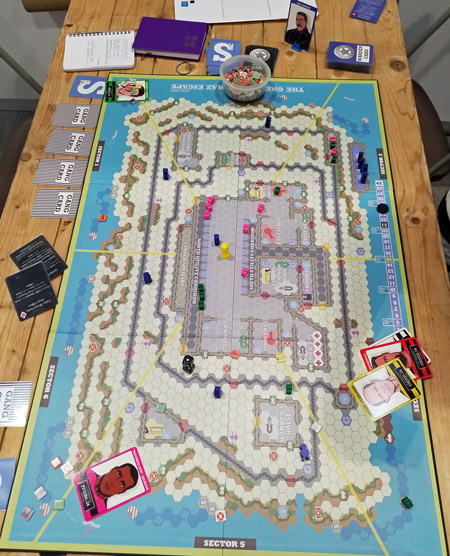
Here's the island prison of Alcatraz. Now all you have to do is escape…
My first thought on seeing The Great Alcatraz Escape was Escape from Colditz! And that is, indeed, the inspiration behind this game of gangs and wardens, designed by Oscar Dingley Gallo. While one player is the Warden, trying to ensure nobody gets off ‘The Rock’, the other players are gang leaders whose goal is to get one of their members to freedom. However, they don’t just have the warden and guards to contend with, the other gangs can (and will!) get in the way. The game lasts 19 rounds to reflect the 19 years that the prison was open. It’s due to appear on Kickstarter later in the year, for the time being there’s more at www.thegreatalcatrazescape.com
The next place we got to sit down was BadCat Games to try Gladiatores: Blood for Roses. The title comes from the rose petal tokens that are players’ rewards – taken from the roses spectators in ancient Rome threw at their favourite gladiators. The game is played across a series of gladiatorial contests, each of which has a certain number of rose petals available.
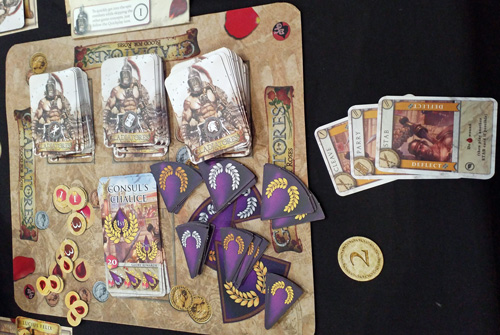
Playing Gladiatores at the Expo
Depending on which gladiator they’ve hired, players have a starting hand of cards and add more from the separate Attack/Defence/Event decks. Then we’re off: the first player chooses an opponent and plays an attack card. If their target plays one of the defences shown on the attack card, the attacker can respond with a follow-up (as shown on the defence card) if they have a suitable card. And so on until one player can’t or won’t play – using your gladiator’s special ability also ends the fight. The last card takes effect and then the next player attacks someone. In the photo I’ve attacked with a Cleave, been parried and have followed up with a stab: can my opponent respond?
Last gladiator standing wins the fight, with players getting extra points according to how many rose petals they have. What makes the game, however, is the initial auction for gladiators before the fight takes place. Plus the ability to bet on the outcome. It looks a cut above most gladiator games, but I do wonder how long it takes to play, given that players have several contests to work through. Gladiatores: Blood for Roses gets a provisional 6/10 on my highly subjective scale.
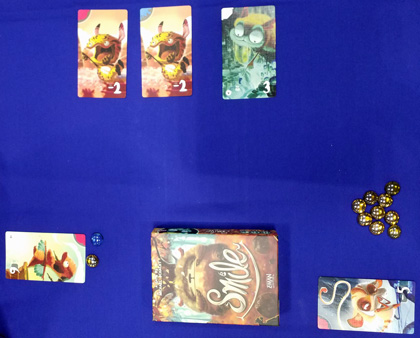
Here’s our game of Smile – the blue chip is a penalty if you run out of fireflies
I do like trying games that are clearly not aimed at my demographic. The cover of Smile features a furry creature wearing a wide, self-satisfied smile. Some of the cuteness goes away when you spot this is a Michael Schacht game from Z-Man Games. At first glance the game looks like No Merci, but there’s actually more going on here.
In their turn, players either add a bead (fireflies, apparently) to the lowest card available (cards can have positive or negative values) or take that card, with the beads on it. The remaining players continue with the next lowest card until everybody’s taken a card. Many cards have a coloured corner and taking a second card of the same colour means you discard both of them. This is a great way of getting rid of a negative card and even better if you can force an opponent to discard a high value card. As in the photo: the -2 red card isn’t useful on its own, but it would remove itself and the -5 if I got it, while Peter doesn’t want it cancelling his 6-point card.
The game plays until the cards have gone, which I thought would take a while but, once we knew what we were doing, the game zipped by pretty quickly. I had a nice, big, negative score, Peter less so and our demonstrator thrashed us! Smile is a cracking little filler, despite the family-friendly artwork. I give it a provisional 8/10 on my highly subjective scale.

Demo of Pocket Landship – note the nice wooden box
I was intrigued by the prototype of Pocket Landship, a solo game of giant tank versus enemy mechs, soldiers and tanks – shades of the venerable O.G.R.E.. Designer Scott Allen Czysz was on hand to explain: the player rolls dice and assigns them to their cards (the component parts of landship) to eliminate enemy cards. Then they roll for the enemy and assign the dice strictly in order (no choosing to minimise damage). Damage to the landship reduces the value of its dice. Pocket Landship is a neat game that was successfully launched on Kickstarter and should be out in November. You’ll find more about it from World Forge Games and there’s a print and play version to try on BGG.

La Stanza in play – six rooms and lots of bits, plus my player board on the left
Given the designers, Nuno Bizarro Sentieiro and Paulo Soledade, I expected La Stanza (published by Quined Games) to be complex. And I was right. It’s about the Renaissance, with players moving around the six ‘rooms’ on the board. These represent different aspects of the period: art, politics, exploration etc. The main mechanism is recruiting a ‘character’ tile from each room and then taking one of the actions in that room. The strength of the action depends on how many characters you have of the corresponding type. Characters are distributed randomly, so it’s important to collect the characters you need before you get to the room. Here’s the board towards the end of a round when most of the characters have been taken.
Most of the actions involve collecting stuff, gaining money and scoring points. There are also ‘masterpieces’ in each room, which need extra strength to achieve, requiring rather more planning. The right bonus tile is useful here and with the final scoring. It’s my kind of game, while not being as complicated as some of the designers’ other games – Nippon, for example. La Stanza gets a provisional 8/10 on my highly subjective scale.
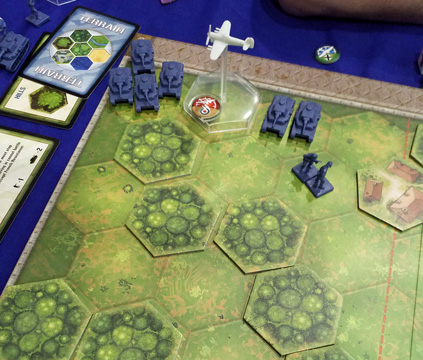
A bit of tank-busting from the Typhoon as we try out Memoir '44: New Flight Plan
One of the many new games distributor Asmodee UK was showing, in this case published by Days of Wonder, was New Flight Plan, the latest expansion for Memoir ’44. This replaces the old, and long out of print, Air Pack expansion. It was billed as providing a simpler implementation of aircraft in the game, so Peter and I had to give it a go.
I immediately saw one significant change from the Air Pack: players don’t have to order their aircraft every turn. Once you’ve got a plane on the board, you order it like any other unit. To keep them from being too powerful, planes have limited ammunition and you can only have one in play at a time. The other new feature is the pack of Air Combat cards. Like other Combat cards, these are played to provide special actions or bonuses – and are also used to deploy aircraft onto the board.
The other simplification is that aircraft are generic fighters, bombers or fighter-bombers, rather than providing specific characteristics for each individual aircraft. The board was laid out for the Mont Mouchet scenario (from the base game), so this is what we played. This pits French Resistance fighters (me) against German infantry who have a couple of armoured units in support (Peter). It was an odd scenario to add aircraft to, but it all worked nicely.
As we had some Air Combat cards at the start, I immediately deployed a fighter-bomber (using the Typhoon model) and strafed the enemy reserves (see photo). In response, Peter played a bomber (the Heinkel 111) that unloaded on some of my troops. What he wasn’t expecting was the anti-aircraft ambush card I played to shoot it down! A few turns later, Peter deployed a fighter-bomber of his own (time for the Stuka model), which took out two of my damaged units. I promptly brought a fighter onto the board (Spitfire, of course) and shot down the Stuka – there are simple rules for aircraft dogfights. That was a win for me 4:2.
On first acquaintance, the New Flight Plan expansion does a much better job of introducing aircraft to the Memoir ’44 battlefield than the Air Pack. Effectively, it gives both players the option of adding an extra unit – one that can be powerful in the right circumstances. The excellent models add flavour. And there are also rules on combining the Air Combat cards with other Combat decks. That’s provisionally 10/10 on my highly subjective scale.
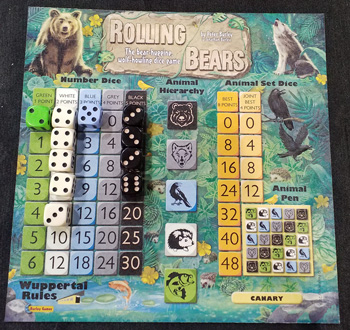
My score board for Rolling Bears :I’ve got 34 points
Following this we bumped into Peter Burley, the man behind Burley Games, and he had a new prototype for us to try. Rolling Bears is a dice drafting game. There are five colours of dice, with increasing points values and an animal head in place of the ‘1’ side – bears are the most valuable dice.
There are, of course, specific rules for what dice players can re-roll when. The key is how the dice score and Peter has provided two different scoring options in the game. We played ‘Wuppertal’ rules: players take sets of the same colour and number or runs of all different colours. All players score the value of the dice they’ve collected and whoever has the best set of animals scores these as well. As the photo shows, players’ boards provide a quick way of totting up the score. You play as many rounds as players and the highest total score wins.
The ‘Hollandica’ scoring option reverses the same/different requirement on set collecting. Animals can be used as wild dice or collected as sets of different animals. This is a neat little game, though it’s clearly aimed more at family play. I look forward to the finished article and give it a provisional 6/10 on my highly subjective scale.
This had taken us to closing time, so it was time for beer and pizza and then into Hall 2 to find gamers – open gaming continues through the evenings in the tournament half of Hall 2, Hall 3 and at the Hilton Metropole. Our evening game was Space Base (designed by John Clair and published by AEG), which seems to be a favourite of Peter’s. It’s a neat little game and I applied the lessons I learned from my last game (see my report from the Gathering in TWJO 194) to win comfortably.
One Hall to go
Saturday is the busiest day of the Expo and Peter had taken himself off to play in the wargame tournament, so I did the rounds chatting to people and having games explained to me. I did get to play a couple of games, though.
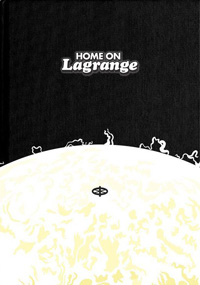
Home on Lagrange, designed by Jordan Anderson-Hyland and Callum Badger, is an intriguing card game of building space stations in the 1970s. And the artwork is suitably retro. It looks good … well, appropriate anyway. At the heart of the game are the large cards representing space station modules of several types. The aim is to complete your station with four modules – and score more points than anyone else.
The small cards are what you use in your turn. These can be played to enhance your station, attack another player or for their monetary value. The most important action is buying a module card, of course. Modules get more expensive with each one you buy, but are only worth their lowest value at the end of the game. Regardless of how many cards you play, you draw just one more to complete your turn.
The game continues until everybody’s built their four modules, which feels a bit odd. Certainly players can continue to enhance their station, but the game could go on for quite a while after the first station’s been completed – especially if players attack those who haven’t finished. Players then score for the value of the modules and other cards in their station.
I really enjoyed this, though it felt quite a light game. The complexity is in the cards, though, so it may well be meatier than my demo game suggested. My favourite touch, though, is the little stories of what happens to your station. There is a different story for each combination of modules, which is terrific. Published by the designers’ imprint, Grizzly Games, it was successfully funded via Kickstarter in 2018 and is now available. Home on Lagrange gets a provisional 8/10 on my highly subjective scale.
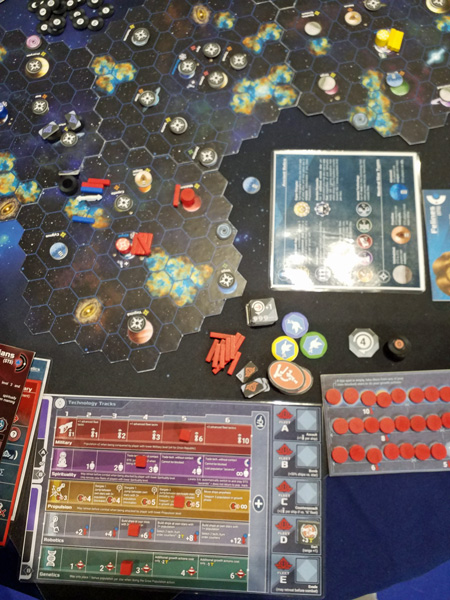
Galactic Era does look like a 4X
Galactic Era, designed by Channing Jones, is an interesting variation on a science fiction 4X game – exploring and conquering the galaxy. In this game, you can choose the light or dark version of your species/culture. Those on the light side don’t interfere with less technologically advanced planets (in best Star Trek prime directive style). However, if you opt for the dark side, you can subjugate and exploit your inferiors. Though this does mean you have difficulty trading. And trading technology is another feature of the game, moving up the technology tree courtesy of other players. Hidden fleet strengths give all players the chance to surprise their opponents. It’s an attractive-looking game and should launch on Kickstarter on November 4th. Publisher Seajay Games has more about the game at the Galactic Era website.
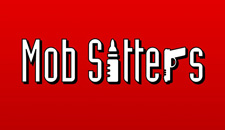 I loved the idea of Mob Sitters,
designed by Paul Brook. Players are baby-sitting the children of mobsters,
where temptation comes along. They can assist the mob, steal from them (doesn’t
sound like a good move to me) or turn them in. And they can finger the other
players. Essentially, it’s a brightly coloured card game of chancing your arm
and shifting the blame. Players start with same set of cards and play three to carry
out an action or defend (played face down). At the end, whoever’s stolen the
most (and been caught) disappears, the most criminal player is arrested, and
whoever has the most loot amongst the rest wins. It looks an absolute hoot and
should be launched on Kickstarter in September by publisher East Street Games.
I loved the idea of Mob Sitters,
designed by Paul Brook. Players are baby-sitting the children of mobsters,
where temptation comes along. They can assist the mob, steal from them (doesn’t
sound like a good move to me) or turn them in. And they can finger the other
players. Essentially, it’s a brightly coloured card game of chancing your arm
and shifting the blame. Players start with same set of cards and play three to carry
out an action or defend (played face down). At the end, whoever’s stolen the
most (and been caught) disappears, the most criminal player is arrested, and
whoever has the most loot amongst the rest wins. It looks an absolute hoot and
should be launched on Kickstarter in September by publisher East Street Games.

Look: a pile of Wing Its and a penguin
Wing It, from Molly Zeff and Flying Leap Games, was new to me, though it was on Kickstarter in 2017 and appeared last year. It’s a game of competitive story-telling, or “extreme storytelling” as it’s billed. Players take turns being the judge, who sets up the scenario, posing an off-the-wall problem for players to solve. Players then tell stories of what they would do in this situation and must incorporate three cards from their hand. The judge then decides which is best. There’s an expansion that adds surprise cards that can be used to interrupt others.
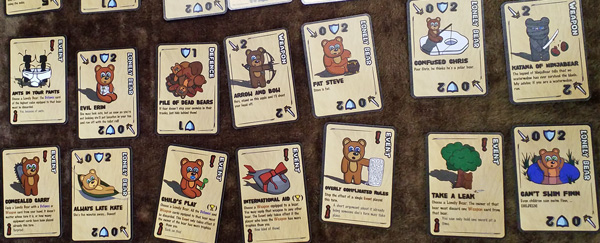
Just some of those Lonely Bears
Lonely Bears, designed by David Campbell and Joshua Subramaniam, has been around for a couple of years, but this was my first encounter with it. It’s a card game of killer teddy bears, described to me as a “casual strategy” game, but it looks like mayhem to me. Players start with two bears and play cards to add weapons/protection and attack other bears. The winner takes the card as a trophy. Event cards interrupt play and do things to other players. It’s nicely illustrated and utterly bonkers. Find out more at lonelybears.co.uk. I picked up a copy, so expect a more detailed review in due course.
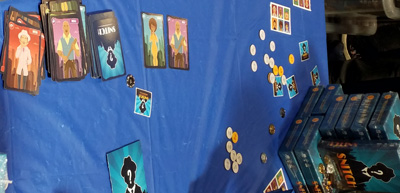
A demo game of Snitch in progress. No, I don't know what's going on
Snitch is subtitled “a fast-paced game of honour among thieves”, which is just flying in the face of received wisdom. Each round is a heist and requires a particular mix of characters to succeed. Any player can contribute characters from their hand and, if they succeed, those who contributed share the spoils. However, one player may be the snitch, who steals from the others if the heist fails. Most money after a set number of rounds wins. Designers Michael Brown, Robert Crowter-Jones, Hai Mac and Sean Micklethwaite (as Slight Games) have come up with an entertaining little game.
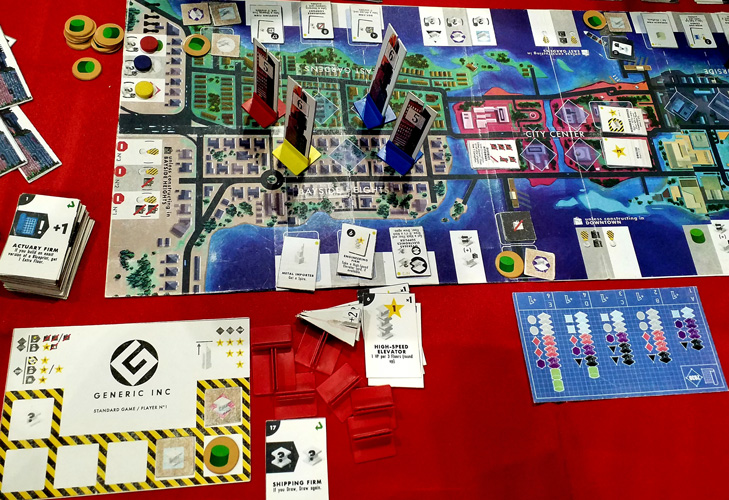
Our game of High Rise gets under way – some skyscrapers are already in place for a shorter game
I do like Gil Hova’s The Networks, so I was keen to have a go at his new game, High Rise, from his imprint, Formal Ferret Games. The aim is to collect the raw materials needed to build skyscrapers matching the available blueprints. All you do each turn is move along the track on the outside of the board. You can move as far as you want, but you won’t get another move until everybody’s gone past you – an old mechanism, but a goodie.
Naturally, many spaces let you pick up raw materials, though you have limited storage (you can expand this), and you can also build a skyscraper if you have the right set of materials. You then get the special action on the space linked to the new skyscraper – this space also gives you a bonus when someone else lands on it. In the photo we’ve just started the demo game, each of us already having a skyscraper on the board.
The other important mechanism is corruption. Players can build faster and get better rewards if they also take corruption markers. At the end of the game, corruption is negative points with extra penalties for the players with most. Playing the demo game, I made a point of having the lowest corruption. I didn’t score a huge number of points for my skyscrapers, but the other players’ corruption brought their scores back to me.
I had great fun playing this, even for just half a game. High Rise is a clever, interesting game that I’m definitely going to be following up on. For the time being it gets a provisional 7/10 on my highly subjective scale.
I noticed a lot of people clutching copies of Villagers, designed by Haakon Gaarder, but failed to find out much about the game due to the crowd at the Sinister Fish stand. They must be doing something right, though.
Saturday evening involved beer, food at the brilliant selection of food trucks outside the Hilton Metropole and chat with some old friends. Then Peter thrashing me at Can’t Stop. That’s the UKGE experience in a nutshell. Brilliant!
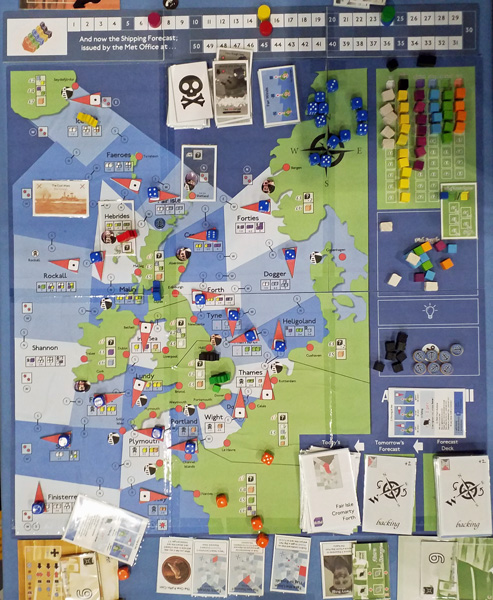
Nearing the end of Attention All Shipping – as the market (top right) is almost full
Sunday is the shortest day of the Expo, which I made shorter with a lie-in. However, I was able to fit in playing two of the three games I wanted to try. First of these was Tony Boydell’s Attention All Shipping prototype. The title gives away that this is a game inspired by the shipping forecast. (An institution on British radio: broadcast at specific times to give weather information to fishing boats around the UK. The roll call of sea areas – Forties, Dogger, Tyne… – is a familiar, soothing litany.)
It’s essentially a pick-up-and-deliver game, with players moving their ships to fish in a sea area (what they catch depends on the dice) and then to sell their catch in a town – there may be some travel in between these two. You have a set number of action points each round, which are used for movement and the number of dice you fish with. Selling fish earns money and most money wins, but you can also spend money to improve your boat (larger hold, bigger engine etc).
Crucial to movement is the weather, represented in each area by an arrow to show wind direction and a die to show strength. Moving with the wind costs fewer action points; against costs more. The fishing boats don’t have modern technology as the game is deliberately set in the 1950s – reflected in the artwork, something I hope makes it through to the production version. The photo on the previous page shows us reaching the end game – I (blue) have a small lead, but it won’t last.
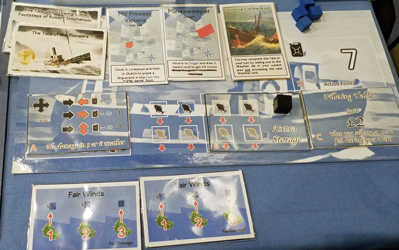
My fishing boat with completed tales top left – and more waiting
On top of this, there are other ways of earning money, hazards to avoid and, best of all, stories to complete. The stories provide a focus to what you’re doing and give players tales to tell. One of my stories was “The Footsteps of Robert [Louis?] Stevenson”, which had me delivering lightbulbs to lighthouses (useful features that negate hazards – once a bulb has been installed).
The game was just as much fun as I expected and I’m looking forward to this even more than Tony’s Alubari, which is due later this year. That’s a highly provisional 8/10 on my highly subjective scale.
The other game on the Surprised Stare stand was Foothills, only a few copies of which were ready in time for the Expo. Designed by Ben Bateson and Tony Boydell, it’s a two-player game developed from Tony’s excellent Snowdonia and published by Lookout Games. Two-player games are not my thing generally and I didn’t take a closer look at this one.

Display of Museum – this isn’t quite how it’s set up to play
My second game on Sunday was Museum from Holy Grail Games, which I’d been eyeing up all weekend as it looked great. Designed by Eric Dubus and Olivier Melison, the idea is that players are each the curator of a museum, looking to fill it with suitable exhibits. The exhibits are gorgeously illustrated cards which players pick up from four geographical groups.
Each card has a value, which you score when you place it onto your museum board. However, to do so, you must also put at least the same value of exhibits into storage. You can get exhibits back out of storage, but other players can take them too – provided they swap in item/s of at least the same value.
The reason to do this is that you’re trying to make sets. Each card comes from a particular civilisation (such as the Celts or the Romans in Europe) and belongs to a particular ‘domain’ (warfare, trade, religion and so on). At the end of the game players get points for the size of their civilisation and domain sets – provided all the exhibits in a set are a contiguous group on their museum board. I’ve got an Indian collection (pink bar at the top of the cards) in my museum in the photo.

My Museum (player board) during the demo game: I have two
domains vertically and the pink Indian civilisation across plus
an expert bottom left and some Prestige points (top right)
Players start with a bonus card that will give them extra points if they achieve a certain goal, providing some initial structure to what they collect. Then there are ‘expert’ cards that can be bought for advantages during play or bonuses at the end. Oh, and I haven’t mentioned the very useful prestige points that can be gathered and either spent during the game or kept to score at the end.
This was great fun to play – helped by my companions at the table – though I can’t help wondering how I managed to get Stonehenge and Machu Picchu into my museum! In fact, this was my favourite of the games I played at the Expo, and I even walked away with a copy. I give it a provisional 9/10 on my highly subjective scale.
The prototype on the Holy Grail stand looked very interesting too, with its board of concentric rings. The theme is rival mining operations on Saturn’s moon, Titan, so it’s no surprise the game is called Titan (designed by Matthieu Podevin). Players purchase, deploy and upgrade equipment to mine deeper and deeper into Titan to extract valuable minerals. However, the only have limited storage space and must try to minimise the inevitable contaminants while collecting the high value stuff. It’s due on Kickstarter in September and I’ll be looking out for it.
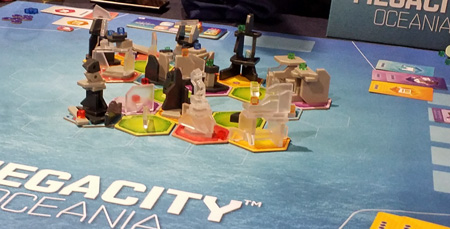
Look at that! Demo game of Megacity: Oceania nearing completion
The game I missed out on (I just ran out of time) was the latest from Hub Games, MegaCity: Oceania, which looked wonderful and was designed by Jordan Draper and Michael Fox. Essentially, players are stacking up odd-shaped translucent plastic pieces (shades of the venerable Bausack – though that’s wooden pieces). These are buildings to add to the growing ‘megacity’. The really tricky bit is that you stack your pieces onto a hexagonal tile in front of you and then have to slide it across the table to the city. I look forward to catching up with it at the next opportunity.
Congratulations and thanks to Richard Denning and the whole Expo team (especially all the volunteers) for another great weekend. The next UK Games Expo is scheduled for 29th-31st May 2020 – keep up to date at their website.
A version of this report was published in To Win Just Once issues 195 and 196 (June-August 2019).


